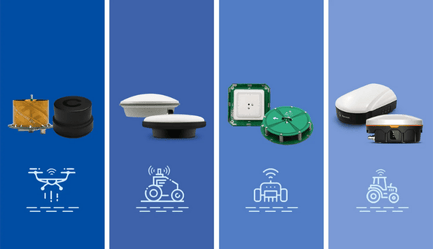

Agriculture is undergoing one of the most significant transformations in history. The shift from traditional methods to precision farming and smart agriculture is driven by the need to produce more food with fewer resources, all while reducing environmental impact. At the center of this evolution is accurate geolocation. Tractors, drones, and field sensors rely on centimeter-level positioning to ensure efficiency and precision. None of this would be possible without the GNSS antenna.
A GNSS antenna is the first and most critical component that connects farm machinery to satellite constellations. It captures weak signals, rejects interference, and delivers clean data to the receiver. Without a reliable antenna, the accuracy of an entire precision farming system can collapse.
One of the primary applications of GNSS antennas in agriculture is auto-steering tractors. With RTK GNSS antennas, farmers can maintain straight, repeatable rows when planting, spraying, or harvesting. This minimizes overlap, saves fuel, and ensures that every square meter of a field is utilized efficiently.
Precision farming is not just about navigation—it is also about variable rate application (VRA) of seeds, fertilizers, and pesticides. A high-quality GNSS antenna for agriculture ensures accurate positioning so machines apply resources exactly where needed. This reduces waste and protects soil health.
In smart agriculture, drones equipped with multi-constellation GNSS antennas map fields, monitor crop health, and guide precision spraying. Ground sensors also require location data to geotag soil samples or weather conditions. In each case, antenna performance directly impacts decision-making.
Not all antennas are equal. In fact, the antenna often determines whether a system delivers centimeter-level precision or struggles with unreliable data. Farmers and integrators should look for these essential features:
Modern GNSS antennas must capture signals from GPS, GLONASS, Galileo, BeiDou, and QZSS. Using multiple constellations improves coverage in challenging environments. Multi-frequency support (L1, L2, L5) also allows for advanced correction methods like RTK and PPP, which are indispensable in precision agriculture.
Agricultural equipment, nearby communication towers, and even natural reflections can introduce signal noise. A strong GNSS antenna incorporates filtering and ground-plane design to minimize multipath effects and interference.
For centimeter-level accuracy, the antenna's phase center must remain stable across frequencies and temperatures. Poor phase stability leads to errors in positioning and directly affects the success of farming operations.
Agriculture is tough on equipment. GNSS antennas for smart farming must resist dust, water, vibration, and extreme temperatures. Long service life and IP-rated protection are essential to keep systems running reliably in the field.
The adoption of GNSS antennas in smart agriculture is expanding rapidly. Some of the most impactful applications include:
Autonomous tractors and harvesters: Guided by RTK GNSS antennas, these machines reduce labor costs and maximize operational efficiency.
Drones and UAVs: Equipped with lightweight antennas, drones map fields, capture NDVI images, and support precision spraying.
Field mapping and soil sampling: Portable GNSS devices with embedded antennas allow farmers to build accurate field maps and monitor soil conditions.
Livestock monitoring and smart fencing: GNSS-enabled collars rely on compact antennas to track movement and manage grazing.
Each application depends on the reliability of the antenna to deliver consistent and accurate positioning data.

While the technical features are critical, selecting the right manufacturer is equally important. A strong antenna supplier ensures consistent quality, long-term product availability, and technical support. This is where Harxon stands out.
Comprehensive product line: From survey-grade GNSS antennas to OEM embedded modules, Harxon offers solutions that meet the needs of tractors, UAVs, and sensor networks.
Multi-constellation coverage: Harxon GNSS antennas support GPS, GLONASS, Galileo, BeiDou, and more—essential for precision farming.
RTK compatibility: Many Harxon antennas are optimized for RTK GNSS farming applications, enabling centimeter-level accuracy in real time.
Ruggedness and reliability: Designed for outdoor conditions, Harxon antennas are tested to withstand dust, water, shock, and temperature extremes.
Global reputation: As a trusted brand in geospatial and agricultural industries, Harxon has proven expertise in enabling precision agriculture worldwide.
Whether you are an agricultural machinery manufacturer, drone developer, or farm operator, choosing a Harxon GNSS antenna means investing in accuracy and long-term performance.
Looking ahead, the role of GNSS antennas in agriculture will only grow. Some key trends include:
Miniaturization: Smaller, lighter antennas will power IoT sensors and drones.
Integration with IoT: Antennas will be embedded in sensor networks, enabling real-time monitoring of soil, crops, and livestock.
LEO satellite augmentation: Next-generation systems will rely on new signals, requiring antennas that support emerging frequency bands.
Hybrid positioning: GNSS antennas will work alongside LiDAR, vision systems, and 5G positioning for enhanced reliability.
The success of precision farming and smart agriculture depends heavily on accurate geolocation. While software and receivers often get the spotlight, the GNSS antenna is the unsung hero that determines the reliability of the entire system. Farmers, system integrators, and equipment manufacturers must prioritize antenna quality to ensure the success of their operations.
With its multi-constellation, multi-frequency products designed specifically for agricultural environments, Harxon offers some of the best GNSS antennas for precision farming. By choosing Harxon, agricultural innovators can rely on a partner that combines performance, durability, and proven expertise.